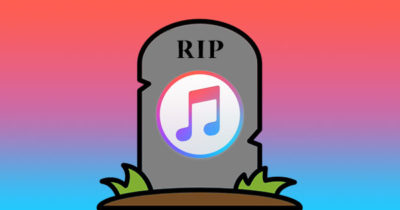Outside Scoop: The End of iTunes, Using 2 Vs. 1 Subwoofer, and More
This week’s Outside Scoop rounds up a handful of articles and videos on music theory, songwriting, recording, mixing, and music business. Some of the most noteworthy pieces of content to be released this week include a look at what happens when iTunes comes to an end, the different circuit types found in Logic’s compressor, 10 free songwriting tools for musicians, using 2 vs. 1 subwoofer, and more. Keep reading to get up to speed on the latest and greatest in the world of music production.
The End of iTunes. What’s Next?
Developer Steve Troughton-Smith has stated in a tweet that “I am now fairly confident based on evidence I don’t wish to make public at this point that Apple is planning new (likely UIKit) Music, Podcasts, perhaps even Books, apps for macOS, to join the new TV app. I expect the four to be the next wave of Marzipan apps. Grain of salt, etc.”
This article by Peter Kirn addresses the projected direction Apple is headed with iTunes, along with what this means for people working in the pro audio industry. He makes it clear that software developers are likely going to capitalize on abandoned iTunes users if Apple heads in a more “consumer-oriented, streaming centric direction.” The real question is who is going to step up to the plate?
Understanding Logic’s Different Compressor Types
If you’re a Logic user, you’ve probably noticed that Logic’s stock compressor provides 7 different circuit types. This makes it an extremely versatile mixing and mastering tool. Mark Cousins of MusicTech walks through all 7 circuit types and describes the characteristic sound they each provide.
9 Mics for Recording Electric Guitar (With Audio Examples)
Not everyone has a stocked microphone locker they can rely on to pull through in every recording situation. Mark Marshall of The Pro Audio Files covers 3 condenser microphones, 3 ribbon microphones, and 3 dynamic microphones specifically for recording electric guitar. The best part about this guide is that he’s included audio examples so you can audition how each microphone sounds yourself. Based off of this, you may be able to fill the holes in your personal microphone collection.
The 10 Best Free Songwriting Tools for Musicians
I was pleasantly surprised by how comprehensive this list of songwriting tools by Clipper Arnold was. It covers things like automatically generating chord progressions, rhyming words together, humming melodies into your phone, and even some browser-based software like iO808 and Bandlab. If you’re a songwriter, I’m quite confident that you’ll find at least a couple of fun and useful new tools within this guide.
How to Make Money From Your Music Video Haters
Black Ghost Audio put together a case study that takes a look at inciting a strong reaction from music video listeners to increase organic reach on social media, and increase the effectiveness of your marketing budget. This article explains how you can catch peoples attention online and provoke them to interact with the comment section of your music videos on Facebook. You have to have pretty tough skin to put up with some of the criticism that comes along with this marketing strategy, but it seems to work quite well.
Mixing Vocals In Studio One With Stock Plugins
Matty, of mixandmastermysong.com, just published an exciting video on mixing vocals with stock Studio One plugins. I’ve mentioned before that Studio One has tons of alluring features and that I’m currently in the process of familiarizing myself with this DAW, so it’s nice to see more people coming out with tutorials using Studio One. Matty actually takes the time to critically listen to the vocals he’s working with and apply processing based on what the vocals require. His workflow is very much focused around a “meet the need” mindset.
How to Fit Diminished Chords Into Your Songs
It’s not uncommon for people to struggle with fitting diminished chords into their songs. They can sound a little eerie, and somewhat out of place if they aren’t resolved appropriately. The Pro Audio Files has put together a video explaining Major and Minor chords, V chords, dominant 7th chords, diminished chords, diminished 7th chords, and modulating with diminished 7th chords. If you have an intermediate understanding of music theory, you should be able to understand and pick up some useful composition skills from this tutorial.
The Best Way to Record Acoustic Guitar At Home
In The Mix demonstrates how to record acoustic guitar using condenser microphones, dynamic microphones, and small diaphragm/pencil condenser microphones. If you’re using a good pair of studio monitors or headphones, you’ll be able to hear the differences in sound quality between the microphones within the video, as well as how the position of the microphones affects the sound they produce. This is a great video to follow along with if you haven’t recorded acoustic guitar before, or if you’re just looking to improve your existing recording ability.
Are Two Subwoofers Better Than One?
Paul from PS Audio believes that two subwoofers are in fact better than a mono subwoofer. He gets into discussing this hotly debated topic at the 4:16 time stamp in the video. Paul’s main point is that even though lower frequencies (around 50-60 Hz) don’t provide our ears with a directional cue, the pressure created by these low-end frequencies may still be enough to provide us with directional cues. Watch the full video to hear more about this controversial subject.
Charles Hoffman is a Mixing and Mastering Engineer at Black Ghost Audio. After graduating from the University of Manitoba with an English degree, Charles completed his education at Icon Collective in Los Angeles, CA.
Please note: When you buy products through links on this page, we may earn an affiliate commission.







